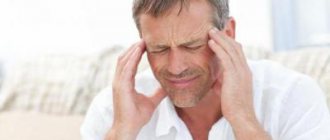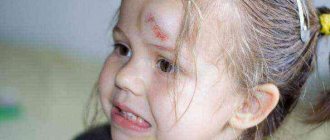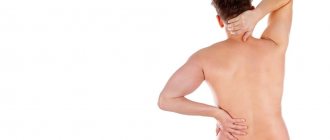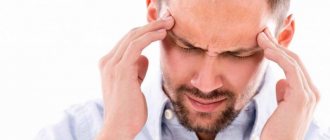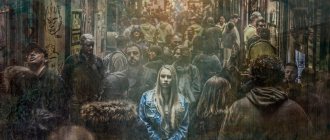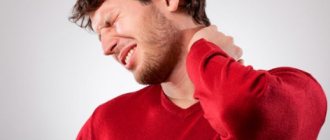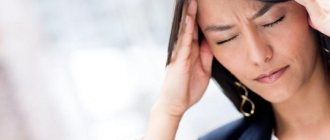What to do if a bump appears on your head due to a blow
Minor injuries that cause swelling or bumps on the head of a child or adult most often occur as a result of play, sports, or a fall when the tissue covering the skull collides with a hard surface. After a bruise, a person often experiences symptoms of a concussion (drowsiness, dizziness). Sometimes there are headaches, aggravated by movement, and less often - post-traumatic amnesia. These symptoms usually last no more than a few hours.
If the appearance of a bump on the head from a blow is accompanied by an unconscious state of the victim, we are talking about a serious injury. It involves the need to ensure airway patency. This type of injury can cause bleeding in the cranial cavity, accompanied by dilated pupils.
When exposed to bright light, the pupils do not constrict. These symptoms indicate swelling of the brain due to excess pressure caused by bleeding.
In some cases, after a short period of full consciousness, the victim returns to an unconscious state, which is typical for bleeding from the middle cerebral artery in the temporal region.
In many cases, minor injuries require only first aid, but follow-up in hospital is advisable as a preventive measure. Severe injuries are always accompanied by hospitalization of the patient. Epidural and subdural hematomas are removed by surgery.
Sometimes a bump on the head after a blow does not go away long enough, and late complications arise, such as post-traumatic epilepsy. Concussion is a very rare cause of epilepsy. In addition to epilepsy, long-term headaches and psychological problems may occur.
But, as a rule, complete recovery occurs.
Dangers of a blow to the head
Most soft bumps on the head of children and adults do not cause complications, but it is important to know the risks of injury to get the full picture and make the right decisions. The most serious consequences of head contusions are cerebral edema and cranial bleeding.
Brain swelling usually forms within 24 hours. Cases where there is no unconsciousness are usually underestimated. A treacherous sense of security also occurs when a person responds well after unconsciousness has subsided.
The brain, skin and soft tissues of the head after injury behave similarly to other bruised parts of the body. For example, a lump on a sprained ankle appears the next day. But unlike the ankle, there is no room for swelling in the brain. There is a maximum of 0.5 cm between it and the wall of the skull, and the cerebrospinal fluid is almost not compressed. Therefore, the swelling expands at the expense of the brain, thereby damaging it.
The same applies to intracranial bleeding, which can accompany bumps on the back of the head in children and adults. A person is threatened not by blood loss, but by its penetration into the confined space of the skull. When there is bleeding into the skull and brain, symptoms appear almost immediately, the most typical of which are loss of consciousness and uneven pupil width.
None of the life-threatening complications can be detected other than by X-ray or CT. The victim's health condition may deteriorate sharply in the coming days.
Immediately after an injury, you cannot even rely on an x-ray image - swelling may not be visible on it. The severity of the condition can only be assessed after several days or even weeks.
If a bump appears on your head after a blow, what should you do and how to prevent possible complications? Despite the good post-traumatic condition of the patient, the absence of these symptoms, amnesia, he should not be left unattended for the next 24 hours.
First of all, it is necessary to treat the wound. It should be anointed with an antibacterial agent (it is recommended to smear it periodically, in accordance with the recommendations on the ointment packaging), if necessary, cover the affected side of the scalp with a bandage.
After treating the wound, the victim should rest (as a rule, a person who has hit his head feels tired). Be careful, in newborns and small children sleep can be confused with loss of consciousness. Therefore, periodically awaken the victim and monitor his condition.
When to go to the doctor with a child after a head injury
Falls among children are among the most common injuries and usually do not require a visit to the doctor. Babies are born “rubbery”: as a rule, they hit the floor and nothing happens to them. But a strong blow can cause a fracture or bleeding. If such injuries are suspected, a medical examination is required.
From birth it is important to keep prevention in mind. Even small children who are not yet moving should not be left unattended on a bed. The baby may suddenly discover this skill, and the risk of injury may be closer than you think.
Baby falls
If a baby happens to fall from a height, this will cause great fear, the natural reaction to which is crying. Take him in your arms and try to calm him down.
Check for injuries, monitor the fontanel (the soft “hole” in the skull between the crown and forehead that allows the cranial bones to move as they pass through the birth canal during childbirth), and monitor his reaction.
If the crying does not stop and blood is flowing from the wound, consult a doctor.
Medical assistance is also needed if a newborn has a lump at the back of the crown or in another part of the head, accompanied by lethargy, vomiting, unconsciousness, a bulging fontanelle, and muscle spasms.
If everything is fine with the baby (at first glance), but you have doubts, contact your pediatrician.
Lack of crying and reaction is a bad sign. Check your baby's vital signs first. Shake or pinch gently. If there is no reaction, check the movements of the chest, listen to his breathing. If breathing is absent or irregular, perform resuscitation (if you know how!) and call an ambulance.
Lump in an older child
If an older child falls from height onto their head, have them assessed immediately. It is important to smear the wound with an antibacterial agent. Observe him for 1-2 days, check him every 2-3 hours at night. Home treatment does not involve the use of painkillers.
You can remove swelling using traditional methods, for example, using a cold compress. If there is pain in or around the watery swelling, consult a doctor.
If you were not present when the injury occurred, try to figure out how it happened. If your child seems lethargic or very tired, go to the doctor immediately.
TBI
Sometimes a bump may be hiding a more serious internal injury (concussion). If you suspect a concussion, take your child to the hospital. Pay attention to possible signs, such as:
- loss of consciousness;
- amnesia;
- confusion;
- vomit;
- pale skin;
- sweating;
- headache;
- discharge of clear or bloody fluid from the ear or nose;
- intermittent speech.
Possible consequences of brain injury:
- memory, speech, concentration, sleep disorders;
- headache;
- movement disorders;
- intellectual impairments.
Prevention
Since children most often tend to get bumps during active games or sports, it is important for older children to buy a helmet that should always be used for cycling, scooters, skating or skiing, or other protective equipment. When traveling in the front seat of a car, a child under 12 years of age must be in a child car seat, and from an older age must be wearing a seat belt.
Source: https://vsepromozg.ru/diagnostika/shishka-na-golove-posle-udara
Signs of Heat Stroke
Symptoms associated with a blow depend on the severity of the victim’s condition.
Mild degree
characterized by:
- the appearance of weakness;
- decreased performance;
- shortness of breath;
- nausea;
- decreased blood pressure;
- headache.
The patient's skin becomes moist and turns red. Consciousness is preserved against the background of a mild degree of pathology.
Average degree
the severity of the impact is manifested:
- severe weakness;
- dryness and hyperemia of the skin;
- headache and dizziness;
- puffiness of the face, swelling of the lower extremities;
- severe vomiting;
- an increase in body temperature to 39-40 o C;
- loud breathing that can be heard from a distance;
- frequent heartbeat, drop in blood pressure.
Confusion and stupor may appear. Sometimes there is loss of consciousness. In such moments, it is important that someone be with the patient, call a team of doctors and provide the necessary assistance.
Severe degree
Heat stroke is characterized by:
- very high body temperature (can reach 41-42 o C);
- headache;
- abdominal pain;
- uncontrollable vomiting.
Delirium, hallucinations, loss of consciousness, and hypotension appear. When examining the victim, it is clear that his skin is red and dry, hot to the touch.
Important! It is necessary to distinguish heat stroke from sunstroke in time. This determines what needs to be done and how to provide assistance to the patient.
Bump on the head from a blow: symptoms, consequences, first aid
If a bump forms on the head from the blow, this indicates that the injury was quite serious. After all, tissue swelling is a sign of damage to blood vessels.
It often happens that the pain from a bruise has long passed, but the bump does not go away. Such swelling hurts when pressed and causes physical and mental discomfort to the person.
How to get rid of a bump on your head yourself? And in what cases should you immediately go to the doctor? We will consider these questions in the article.
Why does a lump appear?
A bump on the head from a blow appears due to damage to small vessels. At its core, it is a type of hematoma. Upon impact, the capillaries rupture and blood flows out. When other parts of the body are bruised, a bruise appears on the skin, but there is usually no swelling. This is due to the fact that the subcutaneous tissue absorbs blood on the body and limbs. Therefore, swelling does not form.
There is no fiber on the head. Blood pours out under the skin. In this case, the liquid is not absorbed, but only accumulates. For this reason, a head injury leads to the appearance of a lump. This does not exclude the simultaneous formation of a bruise if the blow was strong enough.
Causes
A hematoma on the head does not occur with every bruise. In order for a lump to appear, a fairly rough mechanical effect on the skin is necessary. Swelling usually occurs as a result of the following injuries:
- Bumps on a child’s head from an impact are most often caused by falls. Small children often fall out of strollers. Such injuries also occur when a child learns to walk.
- Adults are more likely to get bumps when hitting hard surfaces. This happens with awkward movements or when an object falls on a person from above.
Symptoms
How to distinguish a hematoma from other types of edema and tumors? Bumps on the head from a blow have the following features:
- A hematoma always forms exclusively in the place that has been subjected to mechanical stress. For example, if a person hurts himself on the top of his head, the bump cannot appear in the frontal region.
- The size of the formation may vary. It depends on how severe the bruise was.
- The color of the cone may vary. Sometimes it does not differ from the rest of the skin color, but it may also be bluish due to hemorrhage. But in the head area there are no bruises of such a bright color as on other parts of the body.
- The skin around the lump looks swollen.
- When you press on the lump, pain is felt.
On average, swelling can last from 2 to 7 days. With intensive treatment and proper first aid, the lump goes away quite quickly.
Features of bruises in children
A bump on the head after a blow in a child is a very common occurrence. After all, children love a mobile and active lifestyle. Babies have delicate scalp, so a hematoma can form even with a minor blow.
However, head injuries in children are often accompanied by concussion and other unpleasant consequences. Therefore, you need to pay attention to the baby’s well-being. Many children cry a lot when they are bruised, but most often this is due to fear rather than pain. You need to let the baby calm down, and then take a closer look at his condition. If you have the slightest doubt, you should contact a pediatric traumatologist.
The size of the hematoma does not always indicate the danger of injury. For example, with forehead bruises, huge bumps always form. However, the frontal bone is the strongest and protects the brain well, so unpleasant consequences from bruises in this area are rare.
Cold
Let's say that a child or adult has a bump on their head from a blow. What to do first? A few minutes after the injury, blood continues to flow from the burst vessels, and the lump grows. If the blow was very strong, then the swelling increases right before our eyes.
First of all, you need to stop the subcutaneous hemorrhage. To do this, apply cold to the damaged area. Its effect will help narrow blood vessels and reduce hematoma, as well as reduce pain. The following available tools are suitable for this purpose:
- Ice. If the injury occurred at home, you can take ice from the refrigerator, put it in a bag and wrap it in a towel. Apply an ice compress to the bruised area. This procedure must be repeated several times during the day. Instead of ice, you can use freezer items or a bottle of cold water.
- Compress with cold water. You need to moisten the cloth with cold water and apply it to the bump. As soon as the compress warms up, it must be replaced. This procedure is repeated several times.
- If you don’t have anything cold on hand, regular vegetable oil can help. It should be applied to cotton wool or a bandage and applied to the bruise for half an hour. With the help of such a folk remedy, you can completely avoid the appearance of a bump if the blow was not too strong.
Cold must be applied within the first 24 hours after injury.
Exposure to heat
Cold is a first aid remedy for bumps on the head from a blow. How to treat the hematoma further? Many people limit themselves to only cold compresses on the first day. However, this is not enough. On the second day, the sore spot must be warmed up. Under the influence of heat, the swelling subsides and the lump begins to dissolve.
You can apply a warm boiled egg to the bruise. Table salt, heated in a frying pan and wrapped in a cloth, is also suitable. You should not use compresses that are too hot, so as not to burn your already injured skin.
In the following days, the lump is treated with pharmaceutical ointments or folk remedies.
Ointments
How to anoint a bump on the head from a blow after first aid? In pharmacies you can buy various local remedies for bruises. Let's look at some of them:
- “Troxerutin.” This is a drug in the form of a gel that helps resolve swelling after a bruise. The product is well absorbed into the skin, but it is not recommended to apply it to damaged epithelium. The treated sore spot should be protected from exposure to ultraviolet radiation.
- "Troxevasin". The gel strengthens the walls of damaged blood vessels and promotes their healing. It reduces swelling and relieves pain. The cone should be treated with gel in the morning and evening.
- "Rescuer". This gel stops the inflammatory reaction and heals the injured area of the skin. In addition, it has disinfectant properties.
- “Heparin ointment.” The product is intended to combat thrombosis. However, it is also effective for bumps on the head from a blow. The ointment acts as an anticoagulant and promotes the resorption of hematomas.
- "Lyoton 1000". This gel also has anticoagulant properties and dissolves blood mass under the skin after a bruise.
- “Mirralgin.” The product is a plant-based balm. It improves blood circulation in damaged tissues, relieves pain and swelling. This harmless herbal remedy is especially indicated for young children.
These medications must be used until the lump disappears completely. Treatment may take varying periods of time, depending on the severity of the injury.
Folk remedies
Bumps on the head from a blow can also be cured using folk remedies. Everyone knows the wound-healing properties of aloe and Kalanchoe juice. These plants can be used to make a compress that will help reduce tissue swelling. You need to take a leaf of the plant, remove the top layer from it, put it on the sore spot, and then cover it with film and cotton wool. The compress is kept for about 2-3 hours.
You can use regular cabbage leaves. They need to be crushed and boiled in milk. Then put the mixture on a napkin or cloth and apply it to the bruise. Keep the compress for about 1 hour. This remedy helps relieve swelling.
Bumps on the head from a blow in adults can be treated with a mixture of iodine and alcohol (1:1 proportions). This remedy is especially useful for swelling of a bluish and pinkish color, accompanied by severe subcutaneous hemorrhage.
Possible consequences
It should be remembered that a bump on the head from a blow is not always a harmless phenomenon. After all, the cranium contains the brain, many vessels and nerve nodes. Damage to these anatomical structures can lead to serious consequences:
- concussion;
- skull fracture;
- rupture of cerebral vessels.
It is important to remember that serious head injuries often lead to severe disruptions in the functioning of the central nervous system. Such pathologies often require long-term treatment. Therefore, everyone should know in what cases a lump can be dangerous.
It is necessary to consult a doctor if the bump on the head after the blow does not go away within a week. If swelling does not disappear for a long time, this may indicate trauma to the bone tissue.
Seek immediate medical attention if a child or adult experiences the following symptoms:
- pain in the head and neck area;
- dizziness;
- nausea and vomiting;
- blurred vision;
- strabismus;
- discharge of blood or clear fluid from the nose or ears;
- increase in pain syndrome;
- disorders of speech and consciousness;
- pain that increases when turning the head;
- seizures;
- bleeding from the wound that does not stop for more than 10–15 minutes.
These warning signs may indicate a severe head injury. It is necessary to put the patient to bed, call an ambulance and monitor his consciousness and breathing until the doctors arrive.
Is a lump always associated with a bruise?
A soft bump after a head hit is not dangerous if there are no signs of trauma to the brain or bones of the skull. It is important to remember that a hematoma from a bruise never has a solid structure. If the lump looks like a lump, it is most likely not related to an impact.
Very often, people associate tumors on the head with the fact that they accidentally hurt themselves. However, such bumps may have a completely different origin.
The following formations may occur in the forehead and scalp area:
- Atheromas (wen). They look like balls filled with greasy contents. Festering wen can be painful.
- Hemangioma. This tumor of blood vessels is very similar to a lump after a bruise. However, such a neoplasm has a more intense color than a regular hematoma.
- Fibroma. The tumor consists of connective tissue and is benign. With trauma, malignant degeneration is possible.
- Lymphadenitis. In children, lymph nodes often become enlarged due to inflammation and infections. They look like red, painful bumps. They are usually located on the back of the head or behind the ears.
The appearance of a bump on the head should not be associated solely with the blow. Many of the above tumors require surgical removal. Therefore, if you are not sure that the lump is caused by a bruise, then you need to consult a specialist. Only a doctor can determine the exact cause of the tumor.
Source: https://FB.ru/article/400661/shishka-na-golove-ot-udara-simptomyi-posledstviya-pervaya-pomosch
When a doctor's help is needed
It is necessary to consult a doctor if the bump on the head after the blow does not go away within a week. If swelling does not disappear for a long time, this may indicate trauma to the bone tissue.
Seek immediate medical attention if a child or adult experiences the following symptoms:
- pain in the head and neck area;
- dizziness;
- nausea and vomiting;
- blurred vision;
- strabismus;
- discharge of blood or clear fluid from the nose or ears;
- increase in pain syndrome;
- disorders of speech and consciousness;
- pain that increases when turning the head;
- seizures;
- bleeding from the wound that does not stop for more than 10 - 15 minutes.
These warning signs may indicate a severe head injury. It is necessary to put the patient to bed, call an ambulance and monitor his consciousness and breathing until the doctors arrive.
Lump on the head after a blow: what to do and how to treat – Your own doctor
The appearance of a bump on the head after a blow is an anatomical feature of the scalp. The presence of trabeculae between the tissues of the scalp inhibits inflammatory exudate and bleeding, causing bumps on the scalp from impact.
First aid for injury
This type of injury is more common in children (see Head injuries in children). Good microcirculation and tissue metabolism allow the resulting hematoma to quickly resolve. To do this, you need to follow some recommendations.
What to do if you hit your head and a bump appears? Cold should be applied to the injury site.
To do this, you can use a cold compress, a regular metal spoon, ice from the refrigerator, a special gel pad, a cold element for the freezer, a bottle of cold water, a rubber heating pad with ice or cold water. It is important to keep the cold for a long time, and the greater the blow, the longer the contact with the cold should be.
Recommendation! Take a break periodically so as not to overcool the bruised area and cause local frostbite.
What to do if a child has a bump on the head from a blow? As a rule, this consequence of a head injury goes away in 1–2 days. Pain and swelling only bother you on the first day. Over time, the lump resolves without leaving any changes behind.
The lump in an adult causes virtually no discomfort, except for a short-term cosmetic defect. But children endure their trauma much more emotionally. Firstly, they constantly touch the site of impact and thereby cause painful stimulation. Secondly, they can be repeatedly injured in the same place.
Which doctor should I contact if I have a hard lump on my head? Find out who will help you.
Read what to do if a bump appears on the head of a newborn. Identifying the cause.
Treatment of a bump on the head from a blow using medications
The bruised area can be lubricated with special ointments. They improve lymph and blood flow from the site of injury and thereby help the lump to resolve faster. The following are used as ointments:
- Troxevasin;
- Lyoton-2000;
- Heparin ointment;
- Troxerutin;
- Rescuer;
- It is recommended to use pharmacy Badyaga.
Magnesium will help remove any congestion on the body. Prepare a compress as follows: fold the gauze in several layers, open the ampoule of magnesia and moisten the gauze. Place the cones in place and cover the top with cellophane or parchment paper. This creates a greenhouse effect. The compress needs to be left on for about 5–10 hours.
How to treat a bump on the head from a blow with folk remedies
If the bump on the head does not go away after the blow, then the next day you can apply the following compresses:
- Cabbage leaves are crushed in a meat grinder and boiled a little in milk. Next, apply this paste onto a gauze pad and apply compresses to the site of the lump formation. The compress should be warm. Exposure time is about 1 hour.
- A warm egg is wrapped in a handkerchief and also applied to the bruise site. The same procedure can be carried out with heated salt.
- Another recipe for how to remove a bump on the head from a blow using folk remedies is a compress with vegetable oil. Gauze, folded in several layers, is soaked in oil and applied to the affected area for half an hour. This treatment relieves redness and swelling well.
What are the dangers of head injuries?
If the blow is strong, it can cause a concussion or other negative consequences. What complaints should parents pay attention to after hitting their child's head:
- the presence of a cut or any other damage to the skin;
- presence of bleeding;
- memory loss;
- disorientation in space and impaired recognition of relatives;
- convulsive syndrome, speech impairment;
- headache that gets worse when you move your head or eyes;
- dilation of the pupils, their different diameters (see Anisocoria);
- bleeding from the nose or ears;
- increased body temperature from 37 degrees and above;
- a sharp decrease or increase in blood pressure;
- severe dizziness, nausea and vomiting.
If a child has at least one of the complaints, it is necessary to seek medical help to prevent complications (see Concussion in children).
Do you know why the occipital protuberance is formed on the back of the head and for what reasons the shape of the skull changes?
Read what nutrition should be like for a concussion: healthy foods in the patient’s diet.
Find out why a lump appears on the head and how not to confuse a lump with atheroma.
What diseases are manifested by a bump on the head?
If the bump on the head from the blow does not go away within 3-4 days, then you need to consult a doctor to clarify the circumstances. Diseases that manifest themselves as a bump on the head, unrelated to a blow:
- Lipoma is a benign tumor of adipose tissue, which is why it is often called a “fat.” The formation has a soft consistency, it is mobile, not fused with the surrounding tissues, and grows slowly. Lipoma has different sizes from 0.5 cm in diameter to several centimeters. In rare cases, it can fester, and then surgical intervention cannot be avoided.
- Hemangioma is a benign formation of blood vessels. It differs in that it appears from the first days of birth and has a reddish tint.
- Lymphadenitis is inflammation of the lymph node. It may increase due to a respiratory infection or other somatic diseases and blood diseases.
- Fibroma is a benign tumor of connective tissue.
- Hematoma is a limited accumulation of blood due to vascular damage. A cavity is formed in which blood collects. If a small amount of blood has collected, then the hematoma goes away on its own, but if whole blood clots accumulate, then in this case it is only necessary to drain the hematoma.
What are the dangers of head injuries?
If the blow is strong, it can cause a concussion or other negative consequences. What complaints should parents pay attention to after hitting their child's head:
- the presence of a cut or any other damage to the skin;
- presence of bleeding;
- memory loss;
- disorientation in space and impaired recognition of relatives;
- convulsive syndrome, speech impairment;
- headache that gets worse when you move your head or eyes;
- dilation of the pupils, their different diameters (see Anisocoria);
- bleeding from the nose or ears;
- increased body temperature from 37 degrees and above;
- a sharp decrease or increase in blood pressure;
- severe dizziness, nausea and vomiting.
If a child has at least one of the complaints, it is necessary to seek medical help to prevent complications (see Concussion in children).
Do you know why the occipital protuberance is formed on the back of the head and for what reasons the shape of the skull changes?
Read what nutrition should be like for a concussion: healthy foods in the patient’s diet.
Find out why a lump appears on the head and how not to confuse a lump with atheroma.
Head hit: symptoms, consequences, first aid
Having hit his head hard on a hard surface, a person feels sudden pain. It may not be felt for so long, but a bump on the head after a blow can cause serious discomfort for much longer. Proven methods of traditional medicine and effective medications will help relieve swelling and quickly get rid of unpleasant manifestations.
How a lump appears at the site of a bruise
Symptoms of bruises on different parts of the body may differ qualitatively. If the blow falls not on the head, but on another place, a bruise or hematoma will appear, but the surface of the skin itself will remain smooth. A lump forms on the head.
In general, when a bruise occurs, blood vessels are damaged and burst. Blood flows out of them. On all parts of the body except the head, it is absorbed into the subcutaneous layer of tissue, which leads to a characteristic change in the color of the skin in the bruised area and the appearance of a bruise.
This layer of fiber is almost absent on the head. There is nowhere for blood to be absorbed from the burst vessels. It flows directly into the space between the scalp and the bones of the skull. A lump appears on the head.
The more blood has accumulated at the site of the bruise, the larger the size of the lump.
Actions to reduce and remove the consequences of the impact
The first necessary actions after a bruise to prevent the growth of the lump. At the first stage, it is important to stop the flow of blood from the vessels. To do this, it is necessary to achieve their narrowing. And this needs to be done as quickly as possible. Therefore, first aid consists of providing cold exposure to the site of impact.
A suitable item may be a rag soaked in cold water. You should apply it for a few minutes until it warms up. As necessary, it is necessary to replace the lotion that has become warm with a cold one.
You can use what you have in the refrigerator. It could be ice. You can put it in a plastic bag. The bag should be wrapped in cloth and applied to the bruise. To prevent hypothermia, which can result in complications and illness, it is necessary to apply at intervals.
In addition to ice, there may be some frozen food products in the refrigerator, such as meat. It can also be placed in a bag, wrapped in a cloth or towel and applied to the bump. If you have a cold drink bottle, that can also come in handy.
However, cold objects may not be nearby. For example, the following situation may happen: a man hit his head, a lump appeared, what to do if applying cold is not possible?
In this case, vegetable oil can be of significant help. You need to thoroughly soak a piece of gauze or cotton wool with it and cover the bruised area for 30-35 minutes. The redness that appears after such a compress should go away, but the lump may not appear at all.
Further actions in case of injury
If for the first day the most correct and effective method is exposure to cold, then after this time, actions should be aimed at carefully warming up the impact site. Heat will help get rid of the swelling, relieve swelling, as a result of which the lump will resolve and disappear.
Heated salt retains heat for a long time. Wrapping it in a not very thick cloth, you need to keep the compress on the sore spot. A boiled egg will also remain warm for a long time and can be used for application.
Cabbage
It is an excellent remedy to help cope with swelling and bloating after an impact. First, its fresh leaves should be crushed. It is best to use a meat grinder for this.
The resulting mass should be placed in a small volume of milk and boiled a little. Then, you should take the cabbage out onto a napkin and apply the resulting warm healing compress to the bump for 1 hour.
Then the damaged area must be washed.
Thyme
This plant has healing and swelling properties. Its other name is creeping thyme. Its fresh leaves should be applied to the place where the bump is located on the head after a blow. It is believed that the healing plant even helps restore memory if its decoction is used to wipe the head.
Sagebrush
In a situation of bruise, the juice of the plant effectively helps. To obtain it, the grass should be thoroughly ground. The released juice must then be carefully applied to the bruised area.
Oak bark and daisy flowers
From these components you need to make a powder. Its amount should be equal to one tablespoon. Then you need to prepare a saturated composition by pouring a glass of boiling water over the powder. The solution must be infused for half an hour. A piece of cloth soaked in the resulting liquid is applied to the site of the injury and the consequences of the blow disappear faster.
Gel "Troxevasin"
The product strengthens capillaries and vascular walls, has an effect against swelling and emerging inflammation. The bump on the head is lubricated with gel in the morning and evening. In this case, the medicinal product is smoothly rubbed into the skin until absorbed.
Gel "Troxerutin"
Used to relieve swelling. Well absorbed through the top layer of skin. The product can only be applied if there are no open lesions or wounds. Places treated with gel should be protected from exposure to active sunlight.
Heparin ointment
The product promotes the resorption of blood clots and prevents the formation of new ones. Reduces pain. The ointment is applied in a thin layer in the morning, afternoon and evening until the symptoms of the bruise disappear.
Gel "Rescuer"
Promotes active cell growth and rapid restoration of injured skin. Has an antimicrobial effect. Quickly absorbed. Apply 1-2 times during the day. Apply a thin layer.
When to see a doctor if you have a head injury
If the symptoms of a bruise are only swelling of the lump and pain at the site of the impact, which gradually subsides, then it is not necessary to go to the hospital; it is enough to use the remedies described above. But sometimes the situation can be much more serious.
The injured person may experience not only a bump on the head from a blow, but also signs of a sharp deterioration in their condition as a result of a concussion, intracerebral bleeding, or a fracture of the skull.
Urgent medical assistance is absolutely necessary.
Signs of such particularly severe conditions of the injured person are
- The appearance of open wounds and bleeding from them, which does not stop for more than 10 minutes.
- Feeling of severe pain in the head and neck area.
- Increasing nature of pain.
- Simultaneously with severe pain, attacks of nausea are observed.
- Blood or other fluid is leaking from the ears and nose.
- Increase in body temperature to a value greater than 38 degrees.
- Speech impairment.
- There is a feeling that there is “floating” in the eyes; the pupils are of different sizes.
- Confused consciousness.
If these signs occur, the victim must be taken to the hospital as soon as possible, and until the ambulance arrives, the person should be ensured complete rest and closely monitor his breathing and consciousness.
A bump on the head from a blow may appear to a lesser extent or not appear at all. It all depends on how quickly the situation is assessed and the necessary actions are taken to improve the condition of the injured person.
Source: https://swedmed.ru/shishka/289-golova-udar-delat.html
Compression bandage
Its effect is to some extent similar to cold. But in this case, the process of blood supply to the site of injury is limited mechanically, that is, by reducing the capacity of the vessels.
The use of a bandage should be combined with cold therapy. With a compression bandage, there is no longer any need to wrap ice cubes and other things in cloth. It is enough to place them in a plastic bag and periodically change them as they heat up to maintain the desired temperature of the injured area.
The appearance of a bump on the head after a blow: normal or pathological?
The appearance of a bump on the head after a blow is an anatomical feature of the scalp. The presence of trabeculae between the tissues of the scalp inhibits inflammatory exudate and bleeding, causing bumps on the scalp from impact.
Lump from a medical point of view
The consequences of a bruise to the head and other parts of the body are qualitatively different. Soft tissue injuries are accompanied by the appearance of a hematoma and bruise, but the surface of the skin is not deformed. After a strong blow, an unsightly swelling forms on the head - a bump.
During a bruise, blood vessels are damaged and burst. The blood that flows out of them is absorbed by the subcutaneous layer of fiber. This leads to a change in color of the injured tissue. A bruise appears.
There is practically no such fat layer on the head. The leaked blood accumulates between the tissues of the head and the bones of the skull. A bulge is formed, called a “bump”. Its size depends on the amount of blood leaked.
The lump on the head is formed by blood from capillaries destroyed due to the impact.
First steps to take in case of heatstroke
First you need to assess the condition of the victim. If a person is conscious and his health does not deteriorate, then he has a mild degree of heatstroke. With a mild degree of pathology, the person should be taken to a cool room; if this is not possible, help him move to the shade. If there is no consciousness, the patient should be moved to a cool place.
What to do in case of heatstroke in an adult and a child further:
- call an ambulance;
- remove clothes, leaving only underwear on the body;
- place in a horizontal position, but if there is vomiting, place on one side to prevent aspiration of vomit into the respiratory tract;
- cool the victim’s body in all possible ways (compresses, lotions with cool water, shower, bath, splashing, wiping, directing the fan);
- plenty of drinking regime (it is forbidden to drink alcohol, strong tea, coffee);
- in case of loss of consciousness due to heat stroke, allow the vapors of an ammonia solution to be inhaled;
- monitor pulse, blood pressure, breathing, and perform resuscitation if necessary.
Symptoms and signs
Symptoms depend on the severity of the injury and the extent of the injury. Most often, a regular bruise can be identified by the following signs:
- Pain
in the impact area; - A swelling
appears at the site of injury ; - There is limited collection of blood
(bruising); - Possible nosebleeds;
- There is a slight local and sometimes general increase in temperature;
- With more severe degrees of injury, confusion, weakness, and loss of consciousness may occur.
Note! It is very important to pay due attention to the injury, which results in nausea, loss of consciousness, vomiting, blurred vision and progressive pain. Such a reading is a signal of severe damage.
What is the difference between a head injury and a concussion?
A concussion, as a rule, occurs as a result of injury, including 3-4 degree bruises.
As a result of a concussion, a person experiences symptoms that are unusual for a mild injury
affecting only soft tissues:
- During the injury, mild fainting and loss of consciousness may occur,
- disorientation for a short period of time,
- in addition to the headache, severe dizziness occurs,
- there is tinnitus,
- There may be nausea and vomiting.
It is important! During a concussion, it is difficult to concentrate one’s gaze, there is inhibition of reactions and disorientation in space and time. The person is pale, weak and tired, healthy appetite and sleep disappear.
All these symptoms are not observed with milder degrees of injury; they occur only when the injury is accompanied by a concussion.
Head injury in children
If a child hits his forehead and a bump or bruise appears at the site of the impact, you need to apply ice or something cold
. The frontal bone is quite hard, so in the absence of serious external signs and problems with well-being, the help of a doctor is not required. The swelling will go away on its own within a short period of time.
It is worth taking this injury in infants
, they
should
definitely shown to a pediatrician
. For example, a child falling on the back of his head can have bad consequences. Even with minor external signs (bump, bruise), the child may experience weakness and trembling in the legs. It is better to show the child to a doctor; injury can cause hematomas in the brain, blurred vision, concussion, etc.
Medicines to get rid of lumps
Gel "Troxevasin"
The product strengthens capillaries and vascular walls, has an effect against swelling and emerging inflammation. The bump on the head is lubricated with gel in the morning and evening. In this case, the medicinal product is smoothly rubbed into the skin until absorbed.
Gel "Troxerutin"
Used to relieve swelling. Well absorbed through the top layer of skin. The product can only be applied if there are no open lesions or wounds. Places treated with gel should be protected from exposure to active sunlight.
Heparin ointment
The product promotes the resorption of blood clots and prevents the formation of new ones. Reduces pain. The ointment is applied in a thin layer in the morning, afternoon and evening until the symptoms of the bruise disappear.
Gel "Rescuer"
Promotes active cell growth and rapid restoration of injured skin. Has an antimicrobial effect. Quickly absorbed. Apply 1-2 times during the day. Apply a thin layer.
Mechanical injuries
The formation of a lump on the temple may depend on several factors.
You should always pay attention to the symptoms. Often, a lump under the skin can be caused simply by mechanical trauma received during an impact. Because of their age, kids want to explore the whole world, so the appearance of all kinds of wounds on their bodies is not uncommon.
If a bruise forms around the bump, this almost always indicates that an injury has been sustained. If, after some time, the formation does not begin to decrease, parents need to contact a medical institution. If, in addition to unpleasant sensations in the temporal region, there is also a severe headache, do not hesitate to visit a doctor.
First aid for bruise
The first thing to do is to examine the injured person.
wounds on the skin
or serious abrasions, they need to be bandaged.
If there are hematomas, apply
something
cold
for 20 minutes.
Let the victim lie in bed for several hours. Do not give any medications.
If you have serious symptoms listed above, you should call a doctor. In this case, place the person in the most comfortable position for him and ensure peace.
It is important! Do not let the victim fall asleep until the doctor arrives. Continue to monitor his condition. In case of loss of consciousness, carefully shift the victim to his side, bend his knees closer to his chest, and place his hands under his head.

